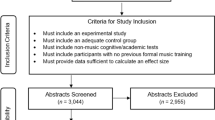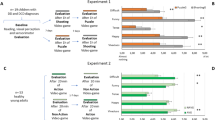Abstract
Previously we developed a method that supports active movement generation to allow practice with improvement of good compliance control in tracing and drawing. We showed that the method allowed children with motor impairments to improve at a 3D tracing task to become as proficient as typically developing children and that the training improved 2D figure copying. In this study, we expanded the training protocol to include a wider variety of ages (5–10-year-olds) and we made the figures traced in training the same as in figure copying, but varied the scale of training and copying figures to assess the generality of learning. Forty-eight children were assigned to groups trained using large or small figures. All were tested before training with a tracing task and a copying task. Then, the children trained over five sessions in the tracing task with either small or large figures. Finally, the tracing and copying tasks were tested again following training. A mean speed measure was used to control for path length variations in the timed task. Performance on both tasks at both baseline and posttest varied as a function of the size of the figure and age. In addition, tracing performance also varied with the level of support. In particular, speeds were higher with more support, larger figures and older children. After training, performance improved. Speeds increased. In tracing, performance improved more for large figures traced by children who trained on large figures. In copying, however, performance only improved significantly for children who had trained on small figures and it improved equally for large and small figures. In conclusion, training by tracing smaller figures yielded better learning that was not, however, specific to the scale of drawn figures. Small figures exhibit greater mean curvature. We infer that it yielded better general improvement.





Similar content being viewed by others
Notes
In previous studies, children would take a long time when completing trials with low attractive force, which would cause frustration. To mitigate this, each trial was terminated if a child could not complete more than one-half of the path within 60 s.
If a child did not beat the competitor fish twice in a row within 6 trials, s/he would automatically advance to the next stage of training.
References
Adolph KE, Robinson SR (2015) Motor development. In: Liben L, Muller U (eds) Handbook of child psychology and developmental science: vol 2: cognitive processes, 7th edn. Wiley, New York, pp 147–170
Asher AV (2006) Handwriting instruction in elementary schools. Am J Occup Ther 60:461–471
Bernstein NA (1967) The co-ordination and regulation of movements. Pergamon Press Ltd, Oxford
Common Core State Standards Initiative (2009). http://www.corestandards.org/. Accessed 1 Mar 2015
Culmer PR, Levesley MC, Mon-Williams M, Williams JHG (2009) A new tool for assessing human movement: the kinematic assessment tool. J Neurosci Methods 184(1):184–192. https://doi.org/10.1016/j.jneumeth.2009.07.025
Graham S (1990) The role of production factors in learning disabled students’ compositions. J Educ Psychol 82:781–791
Graham S, Harris KR (2009) Almost 30 years of writing research: making sense of it all with The Wrath of Khan. Learn Disabil Res Pract 24(2):58–68. https://doi.org/10.1111/j.1540-5826.2009.01277.x
Graham S, Berninger V, Weintraub N, Schafer W (1998) The development of handwriting speed and legibility in grades 1–9. J Educ Res 92(1):42–52
Graham S, Harris KR, Mason L, Fink-chorzempa B, Moran S, Saddler B (2008a) How do primary grade teachers teach handwriting ? A national survey. Read Writ 21:49–69. https://doi.org/10.1007/s11145-007-9064-z
Graham S, Morphy P, Harris KR, Fink-Chorzempa B, Saddler B, Moran S, Mason L (2008b) Teaching spelling in the primary grades: a national survey of instructional practices and adaptations. Am Educ Res J 45(3):796–825. https://doi.org/10.3102/0002831208319722
Henderson SE, Sugden DA, Barnett AL (2007) Movement assessment battery for children-2: movement ABC-2: examiner’s manual, 2nd edn. Pearson Assessment, London
Hogan N (1985) The mechanics of multi-joint posture and movement control. Biol Cybern 52:315–331
Hogan N (1990) Mechanical impedance of single- and multi-articular systems. In: Multiple muscle systems. Springer, New York, pp 149–164
James KH, James TW, Jobard G, Wong ACN, Gauthier I (2005) Letter processing in the visual system: different activation patterns for single letters and strings. Cogn Affect Behav Neurosci 5(4):452–466
Kersey AJ, James KH (2013) Brain activation patterns resulting from learning letter forms through active self-production and passive observation in young children. Front Psychol 4:567. https://doi.org/10.3389/fpsyg.2013.00567
Lacquaniti F, Terzuolo C, Viviani PP (1983) The law relating the kinematic and figural aspects of drawing movements. Acta Physiol (Oxf) 54(1–3):115–130. https://doi.org/10.1016/0001-6918(83)90027-6
Mandelstam J (2015) Should kids learn handwriting? An IU scientist thinks so. Bloom Magazine. http://www.magbloom.com/2015/02/should-kids-learn-handwriting-an-iu-scientist-thinks-so/
Merton PA (1972) How we control the contraction of our muscles. Sci Am 226(5):30–37
Myronenko A, Song X (2010) Point set registration: coherent point drift. IEEE Trans Pattern Anal Mach Intell 32(12):2262–2275. https://doi.org/10.1109/TPAMI.2010.46
Newell KM, Shapiro DC, Carlton MJ (1979) Coordinating visual and kinaesthetic memory codes. Br J Psychol 70(1):87–96. https://doi.org/10.1111/j.2044-8295.1979.tb02147.x
Phillips JG, Ogeil RP, Best C (2009) Motor constancy and the upsizing of handwriting. Hum Mov Sci 28(5):578–587. https://doi.org/10.1016/j.humov.2009.07.004
Proteau L, Marteniuk RG, Lévesque L (1992) A sensorimotor basis for motor learning: evidence indicating specificity of practice. Q J Exp Psychol Sect A 44(3):557–575. https://doi.org/10.1080/14640749208401298
Snapp-Childs W, Casserly E, Mon-Williams M, Bingham GP (2013a) Active prospective control is required for effective sensorimotor learning. PLoS One 8(10):e77609. https://doi.org/10.1371/journal.pone.0077609
Snapp-Childs W, Mon-Williams M, Bingham GP (2013b) A sensorimotor approach to the training of manual actions in children with developmental coordination disorder. J Child Neurol 28(2):204–212. https://doi.org/10.1177/0883073812461945
Snapp-Childs W, Flatters I, Fath A, Mon-Williams M, Bingham GP (2014) Training compliance control yields improvements in drawing as a function of beery scores. PLoS One 9(3):e92464. https://doi.org/10.1371/journal.pone.0092464
Snapp-Childs W, Wang XM, Bingham GP (2016a) Progressive reduction versus fixed level of support during training: when less is less. Hum Mov Sci 45:172–181. https://doi.org/10.1016/j.humov.2015.11.010
Snapp-Childs W, Wang XM, Bingham GP (2016b) Progressive reduction versus fixed level of support during training: when less is less. Hum Mov Sci. https://doi.org/10.1016/j.humov.2015.11.010
Vinci-Booher SA, James KH (2016) Neural substrates of sensorimotor processes: letter writing and letter perception. J Neurophysiol 115(1):1–4. https://doi.org/10.1152/jn.01042.2014
von Hofsten C (1993) Prospective control: a basic aspect of action development. Hum Dev 36(5):253–270
Weintraub N, Graham S (1998) Writing legibly and quickly: a study of children’s ability to adjust their handwriting to meet common classroom demands. Learn Disabil Res Pract 13:146–152
Wilson BN, Crawford SG, Green D, Roberts G, Aylott A, Kaplan BJ (2009) Psychometric properties of the revised developmental coordination disorder questionnaire. Phys Occup Ther Pediatr 29(2):182–202. https://doi.org/10.1080/01942630902784761
Zhao H, Warren WH (2015) On-line and model-based approaches to the visual control of action. Vis Res 110:190–202
Acknowledgements
This work was supported by NICHD R01HD070832.
Author information
Authors and Affiliations
Corresponding author
Rights and permissions
About this article
Cite this article
Snapp-Childs, W., Fath, A.J. & Bingham, G.P. Training children aged 5–10 years in compliance control: tracing smaller figures yields better learning not specific to the scale of drawn figures. Exp Brain Res 236, 2589–2601 (2018). https://doi.org/10.1007/s00221-018-5319-y
Received:
Accepted:
Published:
Issue Date:
DOI: https://doi.org/10.1007/s00221-018-5319-y




